Books by Craig N Cipolla

Archaeology for Today and Tomorrow (Cipolla, Crellin, Harris: Routledge 2024), 2024
Archaeology for Today and Tomorrow explores how cutting-edge archaeological theories have implica... more Archaeology for Today and Tomorrow explores how cutting-edge archaeological theories have implications not only for how we study the past but also for how we think about and prepare for the future. Ranging from how we understand migration or political leadership to how we think about violence or ecological crisis, the book argues that archaeology should embrace a "future-oriented" attitude. Behind the traditional archaeological gaze on the past is a unique and useful collection of skills, tools, and orientations for rethinking the present and future. Further, it asserts that archaeological theory is not only vital for how we conduct our work as archaeologists and how we create narratives about the past but also for how we think about the broader world in the present and, crucially, how we envision and shape the future. Each of the chapters in the book links theoretical approaches and global archaeological case studies to a specific contemporary issue. It examines such issues as human movement, violence, human and non-human relations, the Anthropocene, and fake news to showcase the critical contributions that archaeology, and archaeological theory, can make to shaping the world of tomorrow. An ideal book for courses on archaeology in the modern world and public archaeology, it will also appeal to archaeology students and researchers in general and all those in related disciplines interested in areas of critical contemporary concern.
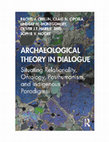
Archaeological Theory in Dialogue: Situating Relationality, Ontology, Posthumanism, and Indigenous Paradigms (Routledge), 2021
Archaeological Theory in Dialogue presents an innovative conversation between five scholars from ... more Archaeological Theory in Dialogue presents an innovative conversation between five scholars from different backgrounds on a range of central issues facing archaeology today. Interspersing detailed investigations of critical theoretical issues with dialogues between the authors, the book interrogates the importance of four themes at the heart of much contemporary theoretical debate: relations, ontology, posthumanism, and Indigenous paradigms. The authors, who work in Europe and North America, explore how these themes are shaping the ways that archaeologists conduct fieldwork, conceptualize the past, and engage with the political and ethical challenges that our discipline faces in the twenty-first century. The unique style of Archaeological Theory in Dialogue , switching between detailed arguments and dialogical exchange, makes it essential reading for both scholars and students of archaeological theory and those with an interest in the politics and ethics of the past.
About the Book: Archaeological Theory in the New Millennium provides an accessible account of the... more About the Book: Archaeological Theory in the New Millennium provides an accessible account of the changing world of archaeological theory. It charts the emergence of the new emphasis on relations as well as engaging with current theoretical trends and the thinkers archaeologist regularly employ. This book will be an essential guide to cutting-edge theory for students and for professional wishing to reacquaint themselves with this field.
Cloth (978-0-8165-3191-2) [s] Cloth ($65.00) Add To Basket Related Interest -Archaeology -Anthrop... more Cloth (978-0-8165-3191-2) [s] Cloth ($65.00) Add To Basket Related Interest -Archaeology -Anthropology

Now available in paperback
Overview:
Historical archeology studies once relied upon a bina... more Now available in paperback
Overview:
Historical archeology studies once relied upon a binary view of colonialism: colonizers and colonized, the colonial period and the postcolonial period. The international contributors to this volume scrutinize imperialism and expansionism through an alternative lens that looks beyond simple dualities to explore the variously gendered, racialized, and occupied peoples of a multitude of faiths, desires, associations, and constraints. Colonialism is not a phase in the chronology of a people but a continuous phenomenon that spans the Old and New Worlds. Most important, the contributors argue that its impacts--and, in some instances, even the same processes set in place by the likes of Columbus--are ongoing.
Inciting a critical study of the lasting consequences of ancient and modern colonialism on descendant communities, this wide-ranging volume includes essays on Roman Britain, slavery in Brazil, and contemporary Native Americans. In its efforts to define the scope of colonialism and the comparability of its features, this collection challenges the field to go beyond familiar geographical and historical boundaries and draws attention to unfolding colonial futures.
Papers by Craig N Cipolla

American Antiquity, 2024
Although land loss is among the most profound impacts that settler colonialism had for Indigenous... more Although land loss is among the most profound impacts that settler colonialism had for Indigenous societies across North America, archaeologists rarely study one of the principal colonial mechanisms of land dispossession: allotment. This process forever altered the course of North American history, breaking up collectively held Indigenous lands into lots "owned" by individuals and families while further stressing local Indigenous subsistence patterns, social relations, political organization, and more. Archaeology's long-term, material, and sometimes collaborative vantage stands to offer insights on this process and how it played out for Indigenous peoples in different times and places. As its case study, this article considers the allotment of Mohegan lands in southeastern Connecticut (USA). An archaeology of Mohegan allotment speaks to more than land loss and cultural change. It provides evidence of an enduring and long-term Indigenous presence on the land; of the challenges faced and overcome by Mohegan peoples living through, and with, settler colonialism; and of the nuances of Indigenous-colonial archaeological records. This study also shows the importance of Indigenous and collaborative archaeologies for shedding new light on these challenging but important archaeological traces.

International Journal of Historical Archaeology, 2023
Through an archaeology of Fort La Cloche, a nineteenth-century Hudson's Bay Company post in Georg... more Through an archaeology of Fort La Cloche, a nineteenth-century Hudson's Bay Company post in Georgian Bay (Lake Huron, Canada), this paper explores parallels between historical archaeology and posthumanism. The posthumanities identify and critique three key problems familiar to historical archaeologists: (1) the arbitrary prioritization of certain types of historical actors (usually White, male, settler colonial) as the apex and standard for all humanity; (2) dichotomous modes of thought that cleave the world into discrete (opposed) categories like "nature" versus "culture"; and (3) human exceptionalism, which frames human beings as fundamentally different-and separate-from all other living and nonliving things surrounding them. An archaeology of La Cloche offers insights into how these broader philosophical goals compare with the work of historical archaeologists. The intersection of the archival record with the archaeological collection, a large and varied assemblage of patent medicine bottles, porcelain doll parts, buttons, shotgun casings, and much more, provides new perspectives on the fur trade; it offers insights into the broader community at La Cloche, peopled not just by powerful company men but by children, woman, workers of various kinds and, of course, Ojibwe and other Indigenous peoples. Historical archaeology also focuses on the material conditions of the fort, documenting complicated and sticky relationships of dependence between people of all sorts and humble, nonhuman things. The paper concludes that historical archaeology and posthumanism stand to benefit from further engagement with one another, making recommendations for further growth.
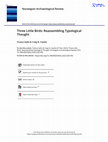
Norwegian Archaeological Review, 2023
The typologies that archaeologists use to classify artefacts and situate them chronologically and... more The typologies that archaeologists use to classify artefacts and situate them chronologically and culturally are crucial tools of the discipline; when left unquestioned, however, they tend to produce reductive and essentializing understandings of the past. Like all theoretical interventions, assemblage theory questions the unquestioned, in this case, asking archaeologists to radically rethink the relationality of the world and the power and vibrancy of nonhuman and nonliving things like stone. In this article, we take an assemblage-based approach to an old typological problem-sorting birdstones. Since the mid-19th century, collectors and archaeologists categorized birdstones found throughout the American Northeast according to evolutionary or culture-historical principles. These approaches paid little attention to different varieties of stone, often regarding birdstones as if they were passive reflections of normative mindsets that came in only three culture-specific types. Here, we explore how archaeologists might 'reassemble' typological thought, analysing and thinking through a large sample of materially varied birdstones to find much more than three little birds. Recognizing how the shared and specific capacities of different stones actively contributed to the multiplicity of birdstone morphologies resituates them as singular and changing assemblages while highlighting the potentials of questioning the fixity of both typological and material categories at large.

Journal of Archaeological Method & Theory, 2023
North American brass projectile points conjure a variety of archaeological narra- tives. Dependin... more North American brass projectile points conjure a variety of archaeological narra- tives. Depending on the interpreter and the context of interpretation, they serve as evidence for: simplistic replacement of local traditions by technologically supe- rior European-introduced materials; the homogenizing forces of global capitalism; nuanced and complicated Indigenous-colonial histories; and/or Indigenous surviv- ance and adaptability. Irrespective of the narratives that they inspire, however, brass projectiles remain under-studied and under-theorized in North American archaeol- ogy. This paper addresses this dearth by analyzing and rethinking a large museum assemblage of brass projectile points from Ontario. The analysis offers insights into the variability and history of brass projectiles, specifically as they relate to lithic tra- ditions. The brass assemblage under consideration points to the significance of New Materialist perspectives on relationality, on post-anthropocentrism, and on change and history. Whereas archaeological habits tend to characterize North American brass projectiles as permutations of “old” plus “new” with minimal engagement with the objects themselves, this paper thinks with brass points, seeking out new angles of understanding that recognize their novelty.
Journal of Contemporary Archaeology, 2021
This paper provides an archaeological perspective on the Boy Scouts of America, placing special e... more This paper provides an archaeological perspective on the Boy Scouts of America, placing special emphasis on Scout camps occupying Mohegan lands in southeastern Connecticut (USA) and focusing on the alteration of Indigenous and Indigenous-colonial sites. Archaeological traces demonstrate how Scouts modified a range of stone features, both ancient and recent, and how they reorganized and redefined the land by naming and bounding their camps. Considering these patterns alongside Scout material culture, including the archaeological remains of Scout habitations, we discuss Boy Scout simulations of Indigenous and Indigenous-colonial histories. Drawing upon Indigenous knowledge and critique, we explore how Boy Scout camps "territorialize" whiteness. This involves the appropriation of Indigeneity as a means of escaping the trappings of...
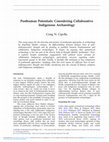
Cambridge Archaeological Journal, 2021
This essay argues for the diversity and promise of posthuman approaches in archaeology by dispell... more This essay argues for the diversity and promise of posthuman approaches in archaeology by dispelling blanket critiques, by differentiating between distinct lines of post- anthropocentric thought and by pointing to parallels between Posthumanism and collaborative Indigenous archaeologies. It begins by arguing that symmetrical archaeology is but one part of the diverse body of thought labelled ‘posthuman’. Next, it explores broader posthuman engagements with political issues relevant for collaborative Indigenous archaeologies, particularly concerns regarding under- represented groups in the field. Finally, it identifies flat ontologies as key components of posthuman approaches, clarifying what this term means for different lines of post- anthropocentric thought and briefly considering how the concept of flatness compares with Indigenous metaphysics.
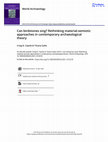
World Archaeology, 2021
Birdstones are an enigmatic and diverse group of objects found across eastern North America with ... more Birdstones are an enigmatic and diverse group of objects found across eastern North America with concentrations around the Great Lakes region. Via specula- tive interpretations of form, analogical comparison with other regions, and consideration of basic contextual information, archaeologists think of birdstones as parts of canoes, flutes, unspecified ceremonial assemblages, and, most fre- quently, atlatls. Discourse and debate about birdstones largely neglects issues of material vibrancy and semiotic process, including the processes by which archae- ologists and others began to name and typify these objects in the late nineteenth century. This paper rethinks birdstones through a ‘more than representational’ approach that combines assemblage theory with Peircean semiotics. Although both lines of thought align with relational ontologies, non-representational critiques, and post-anthropocentrism, archaeologists rarely consider the two together. This approach helps us chart how birdstones emerged and evolved through a complicated set of human-nonhuman interactions that continue into the present.
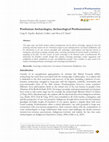
Journal of Posthumanism, 2021
This paper maps and builds relations between posthumanism and the field of archaeology, arguing f... more This paper maps and builds relations between posthumanism and the field of archaeology, arguing for vital and promising connections between the two. Posthuman insights on post-anthropocentrism, non-human multiplicities, and the minoritarian in the now intersect powerfully with archaeology’s multi-temporal and long-term interests in heterogenous and vibrant assemblages of people, places, and things, particularly the last few decades of ‘decolonial’ re- imaginings of the field. For these reasons, we frame archaeology as the historical science of posthumanism. We demonstrate the discipline’s breadth through three vignettes concerning archaeology’s unique engagements with multiplicities of objects, multiplicities of scales, and multiplicities of people. These examples, we argue, speak to the benefits of becoming posthuman archaeologists and archaeological posthumanists.

Canadian Journal of Archaeology, 2021
This report considers copper crescent-shaped objects from Ontario, contextualizing them within br... more This report considers copper crescent-shaped objects from Ontario, contextualizing them within broader archaeological discussions of the Old Copper Complex. I focus on a small assemblage of antiquarian-collected crescents from the Royal Ontario Museum. A literature review comprises the bulk of this report; crescents recovered from sites located in the center of the Old Copper Complex, in current-day Wisconsin and Michigan, help to situate examples in the antiquarian collection. I discuss crescents in terms of their chronolo- gical and geographic breadth, their formal variation, and the different depositional contexts in which they are found. Three examples from the antiquarian collection represent novel forms of copper crescent that are not represented in the accepted typology. Two of these, collected approxima- tely 1,600 km apart from one another, closely resemble stone and copper ulu knives, each with a unique copper handle that once bore a haft. By situating this particular collection within broader discussions of native copper, this report demonstrates the continued importance of thinking through poorly- contextualized archaeological collections while remembering the limitations of rigid, typological thinking.
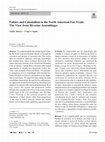
Historical Archaeology, 2020
It is understandable that archaeologists studying the North American fur trade often do so throug... more It is understandable that archaeologists studying the North American fur trade often do so through the excavation and analysis of terrestrial sites. This article takes an alternative approach, analyzing assemblages that resulted from canoe accidents. Recovered from eddies and rocky bottoms of the French and Winnipeg rivers in Ontario, Canada, these collections offer unique opportunities to consider new dimensions of these histories: acute examples of loss and failure. An exploratory comparison of river assemblages with terrestrial fur-trade collections reveals new information on the magnitude of such losses. We argue that these unique fur-trade assemblages demonstrate the need for less anthropocen-tric approaches in historical archaeology that place more emphasis on material affect and nonhuman energy flows (e.g., rivers). We explore this proposition further through close consideration of two of the most common artifact types in the river assemblages: axes and files. Closer attention to the material properties and affordances of these objects offers fresh perspectives on the ways in which materials infused and framed human social relations and capabilities, past and present.
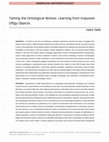
American Anthropologist, 2019
Currently on the rise in archaeology, ontological approaches promise new ways of engaging with al... more Currently on the rise in archaeology, ontological approaches promise new ways of engaging with alterity of various kinds-different people, different times, different forms, even different worlds. This work promises to aid in critical reflections on the arbitrary nature of the Western gaze and to recognize and incorporate non-Western knowledge in new manners. There are, however, several challenges to address. First, as noted by several leading thinkers in this area, the present range of ontological approaches include contrasting theoretical underpinnings. Second, these approaches are rarely considered in relation to the practical challenges of specific archaeological cases, particularly contexts of settler colonialism in which practitioners are attuned to the potential colonial nature of their work. I divide ontologically engaged archaeologies into three related but distinct groups and use a small museum assemblage of seventeenth-century Wendat materials from Ontario to help think through these three theories. In comparing approaches, I outline their respective strengths, weaknesses, and points in need of further clarification. I conclude that the ontological turns offer new and valuable angles of articulation with archaeological materials but that archaeologists must adopt them cautiously if they are to avoid repeating or continuing some of the darkest parts of our (colonial) disciplinary history.
[ontology, archaeology, new materialism, archaeological theory, effigies, colonialism, Iroquoian archaeology, Ontario]
RESUMEN Actualmente se estánest´están desarrollando en la arqueología, aproximaciones ontoí ogicas que prometen nuevas formas de comprometerse con la alteridad de varios tipos-personas diferentes, tiempos diferentes, formas diferentes, aun mundos diferentes. Este trabajo promete ayudar en reflexiones críticas sobre la naturaleza arbitraria de la mirada occidental y para reconocer e incorporar conocimiento no occidental en nuevas formas. Hay, sin embargo , varios retos para abordar. Primero, como señaladose˜señalado por varios pensadores destacados en está area, el rango actual de aproximaciones ontoí ogicas incluye fundamentos té oricos contrastantes. Segundo, estas aproximaciones son consideradas raramente en relací on con los retos prácticospr´prácticos de casos arqueoí ogicos específicos, particularmente los contextos del colonialismo de pobladores en los cuales los profesionales estánest´están sintonizados con la naturaleza colonial potencial de su trabajo. Divido las arqueologías comprometidas ontoí ogicamente en tres grupos relaciona-dos pero distintos y uso un ensamblaje pequeñopeque˜pequeño de museo de materiales de los hurones del siglo XVII de Ontario para ayudar a pensar a travéstrav´través de estas tres teorías. Comparando las aproximaciones, bosquejo sus debilidades, for-talezas respectivas, y puntos en necesidad de clarificací on adicional. Concluyo que los cambios ontoí ogicos ofrecen ´ angulos de articulací on nuevos y valiosos con materiales arqueoí ogicos, pero que los arqué ologos los deben adoptar con cautela si van a evitar repetir o continuar algunas de las partes m ´ as oscuras de nuestra historia disciplinaria

American Antiquity, 2019
There is little doubt that Indigenous, collaborative, and community-based archaeologies offer pro... more There is little doubt that Indigenous, collaborative, and community-based archaeologies offer productive means of reshaping the ways in which archaeologists conduct research in North America. Scholarly reporting, however, typically places less emphasis on the ways in which Indigenous and collaborative versions of archaeology influence our interpretations of the past and penetrate archaeology at the level of theory. In this article, we begin to fill this void, critically considering archaeological research and teaching at Mohegan in terms of the deeper impacts that Indigenous knowledge, interests, and sensitivities make via collaborative projects. We frame the collaboration as greater than the sum of its heterogeneous components, including its diverse human participants. From this perspective, the project produces new and valuable orientations toward current theoretical debates in archaeology. We address these themes as they relate to ongoing research and teaching at several eighteenth and nineteenth-century sites on the Mohegan Reservation in Uncasville, Connecticut.
Il ne fait aucun doute que l'archéologie des nations amérindiennes, l'archéologie collaborative et l'archéologie communau-taire offrent une variété de démarches pour refaçonner la façon dont les archéologues nord-américains effectuent leur recher-che. Toutefois, les publications mettent en général moins l'accent sur la façon dont les archéologies communautaire et amérindienne influencent l'interprétation du passé au niveau théorique. Dans cet article, nous cherchons à combler cette lacune en examinant de façon critique la recherche et l'enseignement effectués chez les Mohegan, surtout en ce qui a trait aux impacts profonds qu'apporte une approche collaborative sur la pratique archéologique en mettant en valeur les connais-sances, les préoccupations et les sensibilités des nations amérindiennes. Nous envisageons la collaboration comme étant plus grande que la somme de ses composantes hétérogènes, y compris les participants humains. De ce point de vue, ce projet propose de nouvelles directions pour les débats théoriques en archéologie. Nous illustrons ces thèmes à travers la recherche et l'enseignement effectués sur plusieurs sites des XVIII e et XIV e siècles situés sur la Réserve Mohegan à Uncasville, Connecticut.

Journal of Archaeological Method and Theory, 2019
Revisiting fur trade collections at the Royal Ontario Museum, this essay explores connections and... more Revisiting fur trade collections at the Royal Ontario Museum, this essay explores connections and potential interplay between historical archaeology and assemblage theory. With few exceptions, archaeologists studying Bmodernity^ over the last 500 years—including those studying the fur trade—have paid little attention to assemblage theory. Also referred to as Bnew materialisms,^ assemblage theory highlights the qualities and vibrancies of substances, their relationality, and their part in energy flows. These distinctly non-anthropocentric emphases present challenges to standard notions of humanity employed in historical archaeology. Building on this general premise, we experiment with B(re)assembling^ historical archaeology by rethinking and reframing aspects of the North American fur trade as it relates to rivers. Archaeological assemblages collected from the beds of several major riverways in Ontario speak to common themes studied in historical archaeology, yet also attest to the ways in which the fur trade depended upon harnessing river power that often acted back in unpredictable and sometimes violent ways. Brought into dialogue with records kept by traders, the collections offer useful perspectives on the deep entanglements between fur trade histories and rivers. From an assemblage perspective, we use these examples to reframe the role of non-human forces in the fur trade and to further challenge dualisms between nature/culture and human/non-human in historical archaeology.







Uploads
Books by Craig N Cipolla
Overview:
Historical archeology studies once relied upon a binary view of colonialism: colonizers and colonized, the colonial period and the postcolonial period. The international contributors to this volume scrutinize imperialism and expansionism through an alternative lens that looks beyond simple dualities to explore the variously gendered, racialized, and occupied peoples of a multitude of faiths, desires, associations, and constraints. Colonialism is not a phase in the chronology of a people but a continuous phenomenon that spans the Old and New Worlds. Most important, the contributors argue that its impacts--and, in some instances, even the same processes set in place by the likes of Columbus--are ongoing.
Inciting a critical study of the lasting consequences of ancient and modern colonialism on descendant communities, this wide-ranging volume includes essays on Roman Britain, slavery in Brazil, and contemporary Native Americans. In its efforts to define the scope of colonialism and the comparability of its features, this collection challenges the field to go beyond familiar geographical and historical boundaries and draws attention to unfolding colonial futures.
Papers by Craig N Cipolla
[ontology, archaeology, new materialism, archaeological theory, effigies, colonialism, Iroquoian archaeology, Ontario]
RESUMEN Actualmente se estánest´están desarrollando en la arqueología, aproximaciones ontoí ogicas que prometen nuevas formas de comprometerse con la alteridad de varios tipos-personas diferentes, tiempos diferentes, formas diferentes, aun mundos diferentes. Este trabajo promete ayudar en reflexiones críticas sobre la naturaleza arbitraria de la mirada occidental y para reconocer e incorporar conocimiento no occidental en nuevas formas. Hay, sin embargo , varios retos para abordar. Primero, como señaladose˜señalado por varios pensadores destacados en está area, el rango actual de aproximaciones ontoí ogicas incluye fundamentos té oricos contrastantes. Segundo, estas aproximaciones son consideradas raramente en relací on con los retos prácticospr´prácticos de casos arqueoí ogicos específicos, particularmente los contextos del colonialismo de pobladores en los cuales los profesionales estánest´están sintonizados con la naturaleza colonial potencial de su trabajo. Divido las arqueologías comprometidas ontoí ogicamente en tres grupos relaciona-dos pero distintos y uso un ensamblaje pequeñopeque˜pequeño de museo de materiales de los hurones del siglo XVII de Ontario para ayudar a pensar a travéstrav´través de estas tres teorías. Comparando las aproximaciones, bosquejo sus debilidades, for-talezas respectivas, y puntos en necesidad de clarificací on adicional. Concluyo que los cambios ontoí ogicos ofrecen ´ angulos de articulací on nuevos y valiosos con materiales arqueoí ogicos, pero que los arqué ologos los deben adoptar con cautela si van a evitar repetir o continuar algunas de las partes m ´ as oscuras de nuestra historia disciplinaria
Il ne fait aucun doute que l'archéologie des nations amérindiennes, l'archéologie collaborative et l'archéologie communau-taire offrent une variété de démarches pour refaçonner la façon dont les archéologues nord-américains effectuent leur recher-che. Toutefois, les publications mettent en général moins l'accent sur la façon dont les archéologies communautaire et amérindienne influencent l'interprétation du passé au niveau théorique. Dans cet article, nous cherchons à combler cette lacune en examinant de façon critique la recherche et l'enseignement effectués chez les Mohegan, surtout en ce qui a trait aux impacts profonds qu'apporte une approche collaborative sur la pratique archéologique en mettant en valeur les connais-sances, les préoccupations et les sensibilités des nations amérindiennes. Nous envisageons la collaboration comme étant plus grande que la somme de ses composantes hétérogènes, y compris les participants humains. De ce point de vue, ce projet propose de nouvelles directions pour les débats théoriques en archéologie. Nous illustrons ces thèmes à travers la recherche et l'enseignement effectués sur plusieurs sites des XVIII e et XIV e siècles situés sur la Réserve Mohegan à Uncasville, Connecticut.
Overview:
Historical archeology studies once relied upon a binary view of colonialism: colonizers and colonized, the colonial period and the postcolonial period. The international contributors to this volume scrutinize imperialism and expansionism through an alternative lens that looks beyond simple dualities to explore the variously gendered, racialized, and occupied peoples of a multitude of faiths, desires, associations, and constraints. Colonialism is not a phase in the chronology of a people but a continuous phenomenon that spans the Old and New Worlds. Most important, the contributors argue that its impacts--and, in some instances, even the same processes set in place by the likes of Columbus--are ongoing.
Inciting a critical study of the lasting consequences of ancient and modern colonialism on descendant communities, this wide-ranging volume includes essays on Roman Britain, slavery in Brazil, and contemporary Native Americans. In its efforts to define the scope of colonialism and the comparability of its features, this collection challenges the field to go beyond familiar geographical and historical boundaries and draws attention to unfolding colonial futures.
[ontology, archaeology, new materialism, archaeological theory, effigies, colonialism, Iroquoian archaeology, Ontario]
RESUMEN Actualmente se estánest´están desarrollando en la arqueología, aproximaciones ontoí ogicas que prometen nuevas formas de comprometerse con la alteridad de varios tipos-personas diferentes, tiempos diferentes, formas diferentes, aun mundos diferentes. Este trabajo promete ayudar en reflexiones críticas sobre la naturaleza arbitraria de la mirada occidental y para reconocer e incorporar conocimiento no occidental en nuevas formas. Hay, sin embargo , varios retos para abordar. Primero, como señaladose˜señalado por varios pensadores destacados en está area, el rango actual de aproximaciones ontoí ogicas incluye fundamentos té oricos contrastantes. Segundo, estas aproximaciones son consideradas raramente en relací on con los retos prácticospr´prácticos de casos arqueoí ogicos específicos, particularmente los contextos del colonialismo de pobladores en los cuales los profesionales estánest´están sintonizados con la naturaleza colonial potencial de su trabajo. Divido las arqueologías comprometidas ontoí ogicamente en tres grupos relaciona-dos pero distintos y uso un ensamblaje pequeñopeque˜pequeño de museo de materiales de los hurones del siglo XVII de Ontario para ayudar a pensar a travéstrav´través de estas tres teorías. Comparando las aproximaciones, bosquejo sus debilidades, for-talezas respectivas, y puntos en necesidad de clarificací on adicional. Concluyo que los cambios ontoí ogicos ofrecen ´ angulos de articulací on nuevos y valiosos con materiales arqueoí ogicos, pero que los arqué ologos los deben adoptar con cautela si van a evitar repetir o continuar algunas de las partes m ´ as oscuras de nuestra historia disciplinaria
Il ne fait aucun doute que l'archéologie des nations amérindiennes, l'archéologie collaborative et l'archéologie communau-taire offrent une variété de démarches pour refaçonner la façon dont les archéologues nord-américains effectuent leur recher-che. Toutefois, les publications mettent en général moins l'accent sur la façon dont les archéologies communautaire et amérindienne influencent l'interprétation du passé au niveau théorique. Dans cet article, nous cherchons à combler cette lacune en examinant de façon critique la recherche et l'enseignement effectués chez les Mohegan, surtout en ce qui a trait aux impacts profonds qu'apporte une approche collaborative sur la pratique archéologique en mettant en valeur les connais-sances, les préoccupations et les sensibilités des nations amérindiennes. Nous envisageons la collaboration comme étant plus grande que la somme de ses composantes hétérogènes, y compris les participants humains. De ce point de vue, ce projet propose de nouvelles directions pour les débats théoriques en archéologie. Nous illustrons ces thèmes à travers la recherche et l'enseignement effectués sur plusieurs sites des XVIII e et XIV e siècles situés sur la Réserve Mohegan à Uncasville, Connecticut.
make substantive contributions to the Tribe, to archaeological pedagogy, and to academic archaeology. We frame our discussion in terms of thebroader implications of these changes and new directions for indigenous, collaborative, and community archaeologies in general.
The course is conducted as an in-person intensive in Connecticut. The course hours are approximately 8:30am to 4:30pm Monday-Friday. Transportation from dormitories to field sites and any course related field trips will be provided. Combination of classroom learning via lectures, speakers, readings, etc. and field learning, including daily fieldwork.
Students interested in enrolling should complete this application: https://forms.gle/ bdPdDuxV1jsQswv37 The program will begin reviewing applications on March 1 and will continue accepting applications until the program is full. Feel free to contact Dr. Craig Cipolla with any questions, Craig.Cipolla @tufts.edu.
Featuring plenary speakers Ben Alberti and Kisha Supernant with presentations from Oliver Harris, Sophie Moore, Rachel Crellin, Lindsay Montgomery, and Craig Cipolla
Opens November 4th, 2017